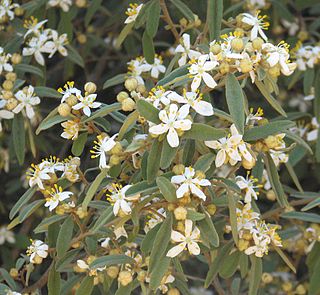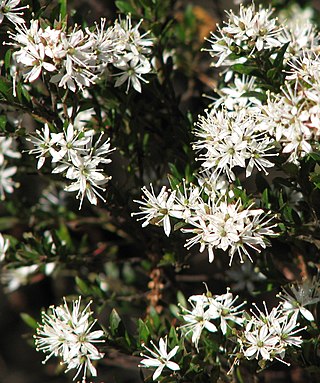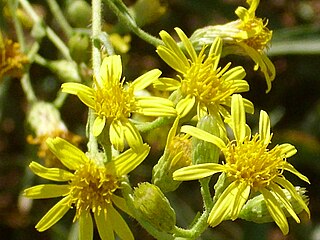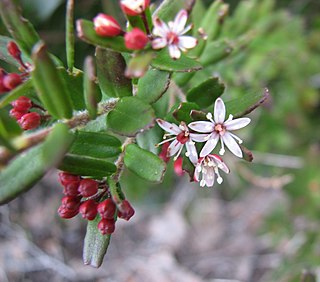
Lysimachia is a genus consisting of 182 accepted species of flowering plants traditionally classified in the family Primulaceae. Based on a molecular phylogenetic study it was transferred to the family Myrsinaceae, before this family was later merged into the Primulaceae.

William Frederick Gibbons is an American rock musician, best known as the guitarist and primary vocalist of ZZ Top. He began his career in Moving Sidewalks, who recorded Flash (1969) and opened four dates for the Jimi Hendrix Experience. Gibbons formed ZZ Top in late 1969 and released ZZ Top's First Album in early 1971. He has also maintained a solo career in recent years, starting with his first album Perfectamundo (2015).

The subfamily Detarioideae is one of the subdivisions of the plant family Fabaceae (legumes). This subfamily includes many tropical trees, some of which are used for timber or have ecological importance. The subfamily consists of 84 genera, most of which are native to Africa and Asia. Pride of Burma and tamarind are two of the most notable species in Detarioideae. It has the following clade-based definition:
The most inclusive crown clade containing Goniorrhachis marginataTaub. and Aphanocalyx cynometroidesOliv., but not Cercis canadensisL., Duparquetia orchidaceaBaill., or Bobgunnia fistuloides(Harms) J. H. Kirkbr. & Wiersema.

Pomaderris is a genus of about 80 species of flowering plants in the family Rhamnaceae, the species native to Australia and/or New Zealand. Plants in the genus Pomaderris are usually shrubs, sometimes small trees with simple leaves arranged alternately along the branches and bisexual, woolly-hairy flowers arranged in racemes or panicles. The flowers are usually yellow and often lack petals.

Asterolasia is a genus of seventeen species of erect or prostrate shrubs in the family Rutaceae, and is endemic to Australia. The leaves are simple and arranged alternately, the flowers arranged in umbel-like groups on the ends of branchlets or in leaf axils, usually with five sepals, five petals and ten to twenty-five stamens. There are seventeen species and they are found in all Australian mainland states but not in the Northern Territory.

Bossiaea is a genus of about 78 species of flowering plants in the pea family Fabaceae and is endemic to Australia. Plants in this genus often have stems and branches modified as cladodes, simple, often much reduced leaves, flowers with the upper two sepal lobes larger than the lower three, usually orange to yellow petals with reddish markings, and the fruit a more or less flattened pod.

Leionema is a genus of more than 20 species of mostly small shrubs in the family Rutaceae, most of which are endemic to eastern Australia. Plants within this genus have scented foliage and clustered, star-shaped flowers which range in colour from cream to bright yellow. Prior to 1998, all species within this genus were included in the genus Phebalium.

Pluchea is a genus of flowering plants in the tribe Inuleae within the family Asteraceae. Members of this genus might be known as camphorweeds, plucheas, or less uniquely fleabanes. Some, such as P. carolinensis and P. odorata, are called sourbushes. There are plants of many forms, from annual and perennial herbs to shrubs and trees, and there is variation in the morphology of leaves, flowers, and fruits.

Lepidosperma is a genus of flowering plant of the family Cyperaceae. Most of the species are endemic to Australia, with others native to southern China, southeast Asia, New Guinea, New Caledonia and New Zealand.

Gahnia is a genus of sedges native to China, Southeast Asia, New Guinea, Australia, New Zealand and a number of Pacific Islands. The common name is due to the toothed margins. It often forms tussocks.

Inuleae is a tribe of flowering plants in the subfamily Asteroideae.

Schoenus is a predominately austral genus of sedges, commonly known as bogrushes, or veldrushes in South Africa. Species of this genus occur mainly in South Africa, Australia and Southeast Asia. Others are found in scattered locations worldwide, from Europe to Asia, North Africa and the Americas. Three species occur in the peatlands of southern South America, including S. antarcticus which is found in Tierra del Fuego, where it forms a component of hyperhumid Magellanic moorland.

Leionema bilobum, commonly known as notched phebalium, is a shrub species of the family Rutaceae. It is endemic to south-eastern Australia. The species was first formally described by English botanist John Lindley from material collected during Thomas Mitchell's exploration of the Grampians. His description was published in 1838 in Three Expeditions into the interior of Eastern Australia. Lindley gave it the name Phebalium bilobum. The species was transferred to the genus Leionema by Paul G. Wilson in 2003. Four subspecies were formally described in 2006:

Scleromitrion is a genus of flowering plants in the family Rubiaceae, native to tropical and subtropical Asia and the western Pacific. The genus was first established in 1834 as a section of the genus Hedyotis, H. sect. Scleromitrion, and was raised to a full genus in 1838.

Machaerina (twigrush) is a genus of flowering plants in the sedge family. Its species occur in tropical America, the West Indies, Malesia, Australia and the Pacific region. The name comes from the Greek machaira, alluding to the shape of the leaves in the type species – Machaerina restioides.
Schizacme archeri is a common alpine cushion-forming plant species endemic to Tasmania, Australia. It grows mostly in the west of the state, south of Cradle Mountain and the Central Highlands. It was previously known as Mitrasacme archeri, but Schizame is now considered its own distinct genus.
Dolichocarpa is a genus of flowering plants in the family Rubiaceae. It includes five species endemic to northern Australia, ranging from Western Australia to the Northern Territory and Queensland.
Phyllangium is a genus of flowering plants in the family Loganiaceae. It includes five species native to southern Australia, ranging across parts of New South Wales, South Australia, Tasmania, Victoria, and Western Australia.















